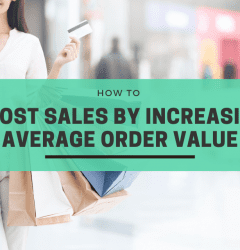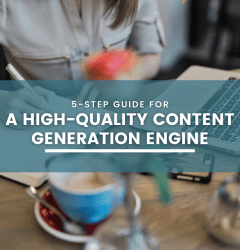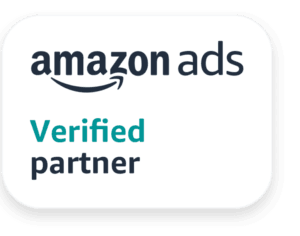This website uses cookies so that we can provide you with the best user experience possible. Cookie information is stored in your browser and performs functions such as recognising you when you return to our website and helping our team to understand which sections of the website you find most interesting and useful.
15 Feb

eCommerce Personalization: Why & What to Personalize on Your Website?
Think about personalization, and the first example that pops in your head is probably Amazon’s ultra-personalized recommendation engine. For ages now, all successful eCommerce brands have known and practiced the art of personalization. In fact, 80% of shoppers are more likely to buy from a company that offers a personalized experience (Epsilon). This understanding is not limited to eCommerce leaders or luxury brand marketers alone — most online businesses today make efforts towards making their web visitors feel like royalty, and it works.
Therefore, it’s important to understand why personalization is such a powerful tool for eCommerce platforms, and what are some of those elements that should be personalized on your website.
Why does eCommerce personalization work?
While it’s clear that personalization is indeed extremely effective, let’s look at some of the reasons that make it an irreplaceable tool in your arsenal:
- Superior customer experience leading to loyalty: eCommerce platforms have an inherent benefit over traditional brick and mortar retail stores because they can provide a tailored experience to every user. Further, it helps customers find precisely what they are looking for, making them stick. 44% of consumers are likely to become repeat buyers after a personalized shopping experience with a particular eCommerce platform (Segment).
- Reduced information overload: Personalization is supremely useful in eliminating excessive information overload. Your users don’t want to be burdened by information about products from all nooks and corners of your website. What they want are products that appeal to them and are relevant to them.
- Higher average order value: With personalized information flowing the user’s way, they are better able to purchase more items per website visit. For example, if a customer visits your website to purchase a laptop, they are more likely to purchase a laptop bag, a wireless mouse, and other such accessories along with it. So, if you offer these products anywhere throughout their journey, they are likely to add these to their shopping carts too!
- Cross-channel personalization experiences: Personalization can be applied in an omnichannel manner for best experiences. For instance, you can connect the user’s online browsing behavior to in-store behavior. This will allow a point-of-sale feedback cycle to ensure that your website’s product recommendations are personalized to match the visitor’s in-store purchases (and vice versa).
- High conversion rates: Personalization ultimately helps your eCommerce business convert more customers. Adopting a personalized approach that caters to your audience’s behavior and liking will help your eCommerce’s success. In fact, 77% of consumers have chosen, recommended, or paid more for a brand that provides a personalized service or experience.
- Benefiting from the notion of selective attention: Selective attention is based on the idea that humans tend to shift their focus and attention to things that drive value to them. Likewise, personalized eCommerce experiences in the form of curated products, targeted ads, and conversational messages can draw the selective attention of potential customers, and nudge them to check more products and make more purchases.
Elements to personalize on your eCommerce website
Whether you have an established eCommerce platform or just beginning with your website, there are some elements that all eCommerce platforms can, and must, personalize to enhance customer experience. Some of these elements include:
- Onsite Search: Your eCommerce’s search functionality and what you can offer along with that will pretty much make or break the user experience. The conversion rates for visitors using search are 1.8x higher than that of the average visitor. Therefore, as a mid-tier or an enterprise level eCommerce platform, this is where you can offer utmost personalization and simplify the user’s experience. This personalization can be done by taking insights from the user’s previous purchases, searches, and browsing history. Below are some things you can look at:
- Search suggestions: The search suggestions should be highly relevant to the user’s intent. For example: someone searching for “men’s slim fit jeans size 32” is much more likely to convert than someone just searching for “men’s jeans”. The broader your user intent, the better personalization works for you. Another great functionality is the auto-complete feature. These are especially helpful when you have multiple products on your website.
- Search results: If your user is searching for a product that comes in different options (colors, design, size, etc.), personalization is a great way to connect them with products that best match their preferences. The personalization engine records every search & purchase related activity by the users (Product Views, Add to carts and Purchases). It then learns from the trends across the attributes engaged with the user. Ultimately, the search results are displayed on the basis of your users’ historical behavior.
- Search filters & Search sorting options: Most visitors will expect to search along with filterable options. You must allow shoppers to sort and filter, not just on the basis of typical options such as size/color/style, but also to include or exclude new items, popular items, sale items, best reviewed items, and so on.All these elements can be tailored to your user to make their browsing experience customized to them.
- Messaging: As an eCommerce brand of any scale (small, mid-tier or enterprise level), you communicate with your customers in many ways. Some of these include:
- Website Copy: You can personalize your copy based on referral source, for example. Let’s say that a user came across an influencer’s post on Instagram that included the link to your brand’s website. The user clicked on it and landed on a generic page, with no mention of any of the products that the influencer talked about. This can be a very frustrating experience. Instead, you make them land on a page that’s specifically designed for the influencer’s audience.
- Transactional messages: For example: sending a personalized order confirmation or money transaction message to the user.
- Promotional messages: Sending personalized newsletters related to special events or sales offers
- Product recommendation messages: Personalized emails with product recommendations based on the user’s past search and shopping behavior can be sent out.
- Others: Onsite messages, onsite popups, welcome messages, and more such.
There is a scope for personalizing each one of the above assets based on the user’s history of engaging with your platform
- Recommendations: If there is anything that comes second in terms of UX to the search system – it’s the recommendation system present on your eCommerce platform, especially for mid-tier and bigger businesses. This brings a lot of scope for personalizing recommendations across the customer’s journey to nudge them towards conversion. You can look at personalizing the following assets:
- Product recommendations: These include complementary products, supplementary products, as well as custom product combos for your users.
- Homepage recommendations: For one of our clients, we deployed a deep learning strategy in a single homepage recommendation widget, as against a traditional collaborative filtering strategy. The result? A whopping 88% increase in revenue and 68% increase in purchases!
- Product page recommendations: A good idea is to capture consumers’ shopping patterns, behavior, purchase history, and wishlist to present recommendations that vary from shopper to shopper. You can also use product pages as a means for upsells and cross-sells.
- Category/search page recommendations: We suggest recommending best-selling products from the categories that your customers have ordered from in the past, rather than bombarding them with products from your entire store. This will help them discover products they might have missed while shopping from your brand in the past.
- Cart page & Checkout page recommendations: These pages can be used as great touchpoints for up-selling and cross-selling techniques. For example: you can use in-cart recommendations to show complementary products to the user while they are still on the shopping cart page. For users who are potentially interested in add-on products but are running short on time or are not heavily invested in the discovery process, these last-minute recommendations are highly useful.
- Order confirmation page recommendations: A good idea is to show ‘products that other customers bought’ on this page. If you do send out order confirmation emails, this is also an excellent way to include discounts or freebies that customers can redeem on future purchases.
- Promotions: Promotions is another area that you can thoroughly customize as per the customer segments you are targeting. This is an important element for all sorts of businesses – whether small, mid-size or large. Some of the common promotional features are:
- Personalized Offers: Offers can be personalized in the following two ways:
a) Creation of a personalized offer for the user: For example, you can display different discount schemes or shipping offers to users in different cities of a country, depending on the spending capacity of your target audience.
b) Selection of the most relevant offer for the user, based on the already existing offers available: For example, you can display different offers or deals to the users, based on the items placed in their cart, the product pages that the user is browsing, the number of items they have in their cart, and so on.
- Personalized Offers: Offers can be personalized in the following two ways:
- Personalized Ads: You can meet customer expectations with precise targeting at every stage of the marketing funnel, by using personalization in ads. This is especially applicable in the case of retargeted ads on Facebook & Google.
- Personalized Timings for Promotion: In essence, you should send out promotional emails or messages at the time when your receiver is most likely to respond or react to the message. That way, you can personalize the time of your promotions for higher conversions. Other than this, you can also go for personalized promotional messages catering to special events in the user’s life, such as Birthdays, Anniversaries, Marriage, Festivals, etc. These can be predicted on the basis of the user’s historical shopping behavior, or through feedback you have collected from the user directly.
- Checkout Process: The final stage of a user’s journey on an eCommerce website – the checkout process – brings with it a lot of personalization options. All of these elements can be personalized and even auto-filled based on the user’s previous engagements. This way, you will save a lot of time and effort of the user, which will help you retain them. These include:
- Address Selection
- Location information that is default to the country of the shopper’s IP address
- Shipping Method Selection
- Payment Method Selection
Tip: We mentioned earlier how personalizing the above assets is important for all eCommerce businesses – whether big or small. While that is true, one thing to keep in mind is that if you’re a small-sized eCommerce business, you should prioritize the elements that will have a higher impact on your conversions, and that are feasible for you to implement. From there, you’ll be on your way to slowly make all the elements personalized.
All in all, personalization is your stairway to connecting with your customers and potentials like never before. It’s up to you to benefit from that or let it go – we recommend you choose the former!
Related Post
Industries Served
United States
India













